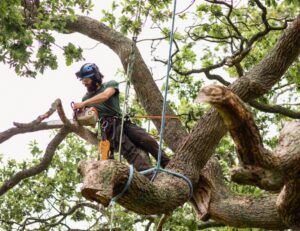The desert climate in Phoenix can present challenges when it comes to tree care. Given the right conditions, diseases can spread across your yard. Unfortunately, you may not be aware that there is an outbreak until it’s too late. One way to avoid this is by knowing different plant illnesses and how they present themselves. To help you with that, here are some of the common plant illnesses in Arizona.
Fungus on Stems and Trunks
Fungi are part of a natural process of nature that facilitates the decay of organic matter. Even though they do not always have adverse effects on the tree’s health, fungus infection can cause hazards. Branches and stems can weaken considerably depending on the age of the plant.
Wood rots are prevalent for landscaping trees in Arizona, such as Cottonwood and Mulberry. One of the symptoms is the hoof-shaped protrusion on the trunks of heartwood and deadwood trees.
Tree trimming is necessary to prevent a hazard in your home. The removal of the infected tissue has to be precise to limit the further spread of the fungus. You may consult a specialist to locate and provide guidance on how to control the disease.
Rust Disease
Rust disease represents a group of fungi with varied characteristics and lifecycles. In the past, rust fungus has devastated species of plants, such as lilies, roses, and carnations, amongst others.
Rust can weaken the trunks and branches to form a shape that is known as the Witches Broom. Control measures involve removing the infected area during the dry season. To prevent disease recurrence, arborists may use various biological and chemical methods.
Powdery Mildew
The powdery mildew is a fungi infection that affects the leaves and stems of flowers and shrubs. It thrives in the arid parts of Arizona under mild-winter conditions. The wind can carry the spores across vast distances. The disease is prevalent in Phoenix for garden plants, such as the Snapdragon.
Fire Blight
Fire blight is a bacteria disease that affects species of plants in the apple family. It is prevalent for pears, apples, and pyracantha. It does not favor the dry conditions of Arizona. But warm, humid weather creates an ideal environment for the bacteria to replicate rapidly.
As the plant blooms, you may spot brown to black streaks on the leaves and flowers. Apple twigs and shoots may lighten as the disease progresses. At advanced stages, cankers may develop, and the infection may move to the flowers.
One way to prevent fire blight is to grow species native to your climate. You can limit its spread by cleaning your tree trimming tools. Prune all the contaminated parts and use house bleach or disinfectant to sterilize the equipment after every cut. Arborists can advise you on chemical control measures to contain the disease, especially during the blooming period.
Soil Salt Saturation
Another cause of disease and plant failure is physiological factors. Excessive use of inorganic chemicals and inadequate drainage can increase salt saturation in desert soils. Different species of plants have varying soil salt requirements. Some of the mineral accumulation signs may include stunted growth, premature defoliation, and marginal burning leaves.
Remember that arborists can help you choose the right species during planting. This goes a long way in ensuring you have healthy trees. However, even having done that, your trees still require time, effort and tree care services to thrive.



